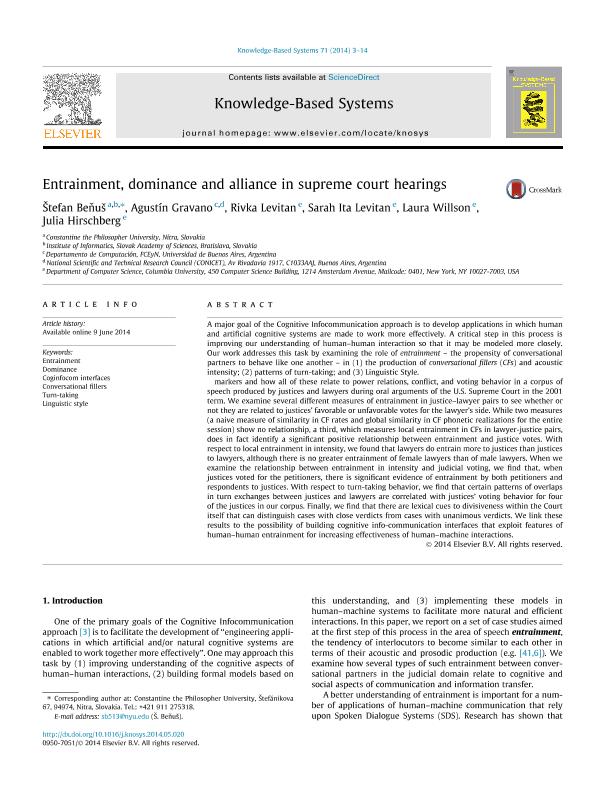Mostrar el registro sencillo del ítem
dc.contributor.author
Beňuš, Stefan
dc.contributor.author
Gravano, Agustin

dc.contributor.author
Levitan, Rivka
dc.contributor.author
Levitan, Sarah Ita
dc.contributor.author
Willson, Laura
dc.contributor.author
Hirschberg, Julia
dc.date.available
2019-09-26T15:40:28Z
dc.date.issued
2014-11
dc.identifier.citation
Beňuš, Stefan; Gravano, Agustin; Levitan, Rivka; Levitan, Sarah Ita; Willson, Laura; et al.; Entrainment, dominance and alliance in supreme court hearings; Elsevier Science; Knowledge-Based Systems; 71; 11-2014; 3-14
dc.identifier.issn
0950-7051
dc.identifier.uri
http://hdl.handle.net/11336/84533
dc.description.abstract
A major goal of the Cognitive Infocommunication approach is to develop applications in which human and artificial cognitive systems are made to work more effectively. A critical step in this process is improving our understanding of human-human interaction so that it may be modeled more closely. Our work addresses this task by examining the role of entrainment - the propensity of conversational partners to behave like one another - in (1) the production of conversational fillers (CFs) and acoustic intensity; (2) patterns of turn-taking; and (3) Linguistic Style. markers and how all of these relate to power relations, conflict, and voting behavior in a corpus of speech produced by justices and lawyers during oral arguments of the U.S. Supreme Court in the 2001 term. We examine several different measures of entrainment in justice-lawyer pairs to see whether or not they are related to justices' favorable or unfavorable votes for the lawyer's side. While two measures (a naive measure of similarity in CF rates and global similarity in CF phonetic realizations for the entire session) show no relationship, a third, which measures local entrainment in CFs in lawyer-justice pairs, does in fact identify a significant positive relationship between entrainment and justice votes. With respect to local entrainment in intensity, we found that lawyers do entrain more to justices than justices to lawyers, although there is no greater entrainment of female lawyers than of male lawyers. When we examine the relationship between entrainment in intensity and judicial voting, we find that, when justices voted for the petitioners, there is significant evidence of entrainment by both petitioners and respondents to justices. With respect to turn-taking behavior, we find that certain patterns of overlaps in turn exchanges between justices and lawyers are correlated with justices' voting behavior for four of the justices in our corpus. Finally, we find that there are lexical cues to divisiveness within the Court itself that can distinguish cases with close verdicts from cases with unanimous verdicts. We link these results to the possibility of building cognitive info-communication interfaces that exploit features of human-human entrainment for increasing effectiveness of human-machine interactions.
dc.format
application/pdf
dc.language.iso
eng
dc.publisher
Elsevier Science

dc.rights
info:eu-repo/semantics/openAccess
dc.rights.uri
https://creativecommons.org/licenses/by-nc-nd/2.5/ar/
dc.subject
COGINFOCOM INTERFACES
dc.subject
CONVERSATIONAL FILLERS
dc.subject
DOMINANCE
dc.subject
ENTRAINMENT
dc.subject
LINGUISTIC STYLE
dc.subject
TURN-TAKING
dc.subject.classification
Ciencias de la Computación

dc.subject.classification
Ciencias de la Computación e Información

dc.subject.classification
CIENCIAS NATURALES Y EXACTAS

dc.title
Entrainment, dominance and alliance in supreme court hearings
dc.type
info:eu-repo/semantics/article
dc.type
info:ar-repo/semantics/artículo
dc.type
info:eu-repo/semantics/publishedVersion
dc.date.updated
2019-09-24T12:52:09Z
dc.journal.volume
71
dc.journal.pagination
3-14
dc.journal.pais
Países Bajos

dc.journal.ciudad
Amsterdam
dc.description.fil
Fil: Beňuš, Stefan. Slovak Academy Of Sciences; Eslovaquia
dc.description.fil
Fil: Gravano, Agustin. Consejo Nacional de Investigaciones Científicas y Técnicas; Argentina. Universidad de Buenos Aires. Facultad de Ciencias Exactas y Naturales. Departamento de Computación; Argentina
dc.description.fil
Fil: Levitan, Rivka. Columbia University; Estados Unidos
dc.description.fil
Fil: Levitan, Sarah Ita. Columbia University; Estados Unidos
dc.description.fil
Fil: Willson, Laura. Columbia University; Estados Unidos
dc.description.fil
Fil: Hirschberg, Julia. Columbia University; Estados Unidos
dc.journal.title
Knowledge-Based Systems

dc.relation.alternativeid
info:eu-repo/semantics/altIdentifier/url/http://www.sciencedirect.com/science/article/pii/S0950705114002184
dc.relation.alternativeid
info:eu-repo/semantics/altIdentifier/doi/http://dx.doi.org/10.1016/j.knosys.2014.05.020
Archivos asociados
